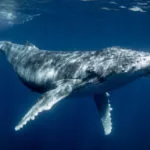
(NEW YORK) — July marks the peak of the humpback whale’s 6,000-mile migration north to Queensland, Australia’s warmer waters, where they mate and give birth.
“We think we have more whales in the population than we did pre-whaling,” professor Mike Noad, director of the Centre for Marine Science at the University of Queensland, told ABC News.
This season, he expects 40,000 humpbacks to pass Eastern Australia.
“We won’t know the exact number until we do another big survey,” Noad said. “We haven’t had funding for that since 2015.”
Last week, a citizen science migration census conducted by the Organization for the Rescue and Research of Cetaceans (ORRCA) recorded 5,116 humpbacks, a 57% annual increase. It’s an incredible recovery for Australia’s humpbacks, whose populations mysteriously crashed in 1961. They were registered under the endangered species act in the U.S. in 1973.
“We should leave a desert in our wake”
The bloody story of how Australia’s humpbacks reached near extinction only came to light with the fall of the Soviet Union, in part thanks to the work of husband-and-wife marine biologists Philip Clapham and Yulia Ivashchenko.
Starting in 1948, the USSR ignored restrictions implemented by the International Whaling Commission and conducted a 30-year campaign of illegal whaling in the rich feeding grounds of the Antarctic, Clapham told ABC News from their home on Vashon Island, Washington state.
“They were doing this completely in secret,” he added.
“They were submitting falsified catch data to the International Whaling Commission but keeping the secret data to themselves,” he continued.
According to Clapham, “The Soviets claimed they had taken 2,710 humpback whales in the southern hemisphere over a period of many years. The actual number was close to 30,000, all taken from the Antarctic.”
Soviet whaling in the southern hemisphere was responsible for almost one quarter of the total number of humpback whales killed in the 20th century.
“Twenty-six thousand were taken in just two seasons: 1959-60 and 1960-61,” Clapham confirms.
This, together with the poorly managed “legal” whaling of other nations, devastated populations.
Clapham and Ivashchenko spent years amassing the data from archives.
“One whaler kept 72,000 catch records in his potato cellar in Kaliningrad until the end of the Cold War,” Clapham said.
In an incredible feat, humpback whales were removed from Australia’s threatened species list last year.
“It hasn’t required much. Just stopping killing them was enough,” Noad said. “They recovered nicely under their own steam, which is very pleasing.”
Australia’s “Humpback Highway,” as experts call it, presents its own problems for ORRCA.
ORRCA volunteer Jacqueline O’Neill told ABC News that on a busy day, they can receive upward of one hundred plus callouts. Most come from fishermen reporting entanglements or concerned members of the public reporting vessels flouting Australia’s strict exclusion zones.
Carrying capacity and Climate Change
While marine scientists hope Australian humpback populations have leveled off, some fear they could overshoot carrying capacity.
“This is basically the ability of the environment to feed that many whales,” Noad explained from Heron Island on the Great Barrier Reef.
“What happens then is the whales start getting thinner because there’s not enough food, and then they stop reproducing,” he added.
Noad warns the conundrum facing scientists is distinguishing this from the impact of climate change on krill populations in the Antarctic, where the whales go to feed in the summer.
“Krill goes hand in hand with climate change,” he said.
The small crustaceans feed on algae under the sea ice, and with diminished sea ice, it’s likely this would cause a decrease in krill, devastating for the Antarctic ecosystem.
“In the Antarctic, everything either eats krill or eats something that eats krill,” Noad said.
For now, Australians like Mark Wong are relishing the thriving migratory season.
“It’s addictive,” Wong, a whale watcher and accountant, said. “It’s like watching a bus propel itself out of the water.”
Copyright © 2023, ABC Audio. All rights reserved.
